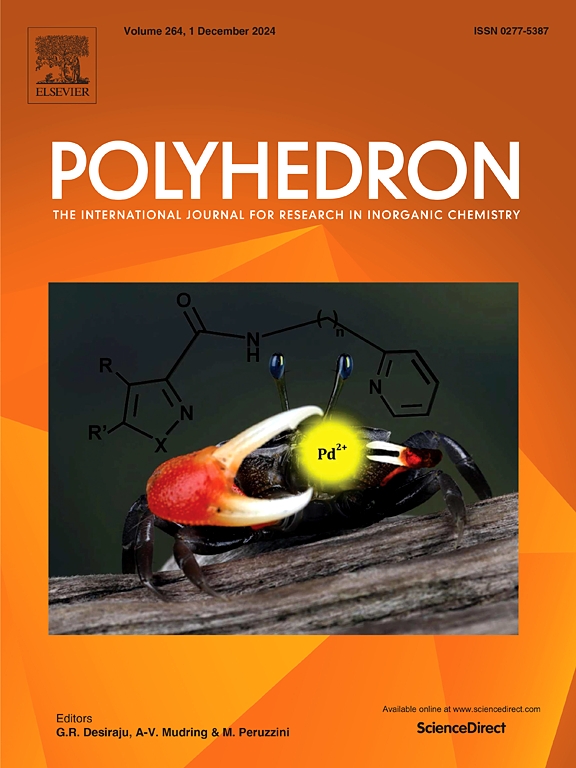Synthesis, crystal structures and cytotoxic activity of new Cu(II) complexes based on podands with terminal 8-oxyquinolyl groups
IF 2.4
3区 化学
Q2 CHEMISTRY, INORGANIC & NUCLEAR
引用次数: 0
Abstract
In this study, we present the synthesis of four novel Cu(II) complexes based on podands with terminal 8-oxyquinolyl groups and evaluation of their potential anticancer activity. The syntheses of ligands were achieved by a unified procedure in which 1,5-bis(8-oxyquinolyl)-3-oxapentane (L1), 2,6-bis((8-oxyquinolyl)methyl)pyridine (L2), 1,8-bis(8-oxyquinolyl)-3,6-dioxaoctane (L3) were prepared by a one-step reaction of 2 equiv. of 8-hydroxyquinoline sodium salt with diethylene glycol ditosyl, 2,6-bis(tosylatemethyl)pyridine and triethylene glycol ditosyl, respectively, in good yields. The synthesis of copper(II) complexes [Cu2L1Br2(µ-OCH3)2] (1), [Cu2L1Br2(µ-OH)(µ-Br)] (2), [Cu2L1Br2(µ-Br)2]·CH3CN (3), and [CuL2Br]Br (4) was performed through the reaction of CuBr2 with L1 and L2 ligands under mild conditions. Single crystal X-ray diffraction analysis revealed that complexes 1–3 possessed binuclear structures, while complex 4 exhibited a mononuclear configuration. The in vitro anticancer activities of the four complexes were evaluated against four different cancer cell lines. The complexes exhibited higher activity compared to their respective free ligands, inducing cell growth inhibition and apoptosis in a concentration-dependent manner. Compounds 3 and 4 exhibited the most pronounced cytotoxic effect against the A549 cell line, with IC50 values of 21.43 ± 0.20 and 30.67 ± 2.23 μM, respectively. It is also noteworthy that lower IC50 values were observed for all compounds against Hek-293 cells of normal origin. A selectivity index of 2 was calculated for compound 3. According to study of the effect on apoptosis, compounds 1 and 4 at the selected concentration after 24 h significantly increased the percentage of the apoptotic population. Confocal microscopy revealed that all the synthesized complexes penetrate into the cells and localize in the perinuclear space. It is suggested that aberrant glycolysis is one of the primary targets of the action of Cu(II) complexes 1–4, and the detected cytotoxic activity appears to be related to the ability of 1–4 to alter the pathological mechanism of tumor cell metabolism.

末端含8-氧喹啉基团的新型铜(II)配合物的合成、晶体结构和细胞毒活性
在本研究中,我们合成了四种基于末端8-氧喹啉基团的新型铜(II)配合物,并对其潜在的抗癌活性进行了评价。配体的合成采用统一的程序,分别以2等量的8-羟基喹啉钠盐与二乙二醇二元基、2,6-二(甲氧喹啉基)吡啶和三乙二醇二元基一步反应制备1,5-二(8-氧喹啉基)-3-二氧喹啉基(L2)、2,6-二(甲氧喹啉基)吡啶和1,8-二(8-氧喹啉基)-3,6-二氧喹啉基(L3),收率较高。通过CuBr2与L1和L2配体在温和条件下的反应,合成了铜(II)配合物[Cu2L1Br2(µ-OCH3)2](1)、[Cu2L1Br2(µ-OH)(µ-Br)](2)、[Cu2L1Br2(µ-Br)2]·CH3CN(3)和[CuL2Br]Br(4)。单晶x射线衍射分析表明,配合物1-3为双核结构,配合物4为单核结构。研究了四种复合物对四种不同肿瘤细胞系的体外抗癌活性。与它们各自的自由配体相比,这些复合物表现出更高的活性,以浓度依赖的方式诱导细胞生长抑制和凋亡。化合物3和4对A549细胞系的细胞毒作用最显著,IC50值分别为21.43±0.20 μM和30.67±2.23 μM。同样值得注意的是,所有化合物对正常来源的Hek-293细胞的IC50值都较低。对化合物3的选择性指数为2。对细胞凋亡的影响研究表明,化合物1和4在所选浓度下作用24 h后,细胞凋亡群体百分比显著增加。共聚焦显微镜显示所有合成的复合物穿透细胞并定位于核周空间。提示异常糖酵解是Cu(II)复合物1-4作用的主要靶点之一,检测到的细胞毒活性似乎与1-4改变肿瘤细胞代谢病理机制的能力有关。
本文章由计算机程序翻译,如有差异,请以英文原文为准。
求助全文
约1分钟内获得全文
求助全文
来源期刊

Polyhedron
化学-晶体学
CiteScore
4.90
自引率
7.70%
发文量
515
审稿时长
2 months
期刊介绍:
Polyhedron publishes original, fundamental, experimental and theoretical work of the highest quality in all the major areas of inorganic chemistry. This includes synthetic chemistry, coordination chemistry, organometallic chemistry, bioinorganic chemistry, and solid-state and materials chemistry.
Papers should be significant pieces of work, and all new compounds must be appropriately characterized. The inclusion of single-crystal X-ray structural data is strongly encouraged, but papers reporting only the X-ray structure determination of a single compound will usually not be considered. Papers on solid-state or materials chemistry will be expected to have a significant molecular chemistry component (such as the synthesis and characterization of the molecular precursors and/or a systematic study of the use of different precursors or reaction conditions) or demonstrate a cutting-edge application (for example inorganic materials for energy applications). Papers dealing only with stability constants are not considered.
 求助内容:
求助内容: 应助结果提醒方式:
应助结果提醒方式:


